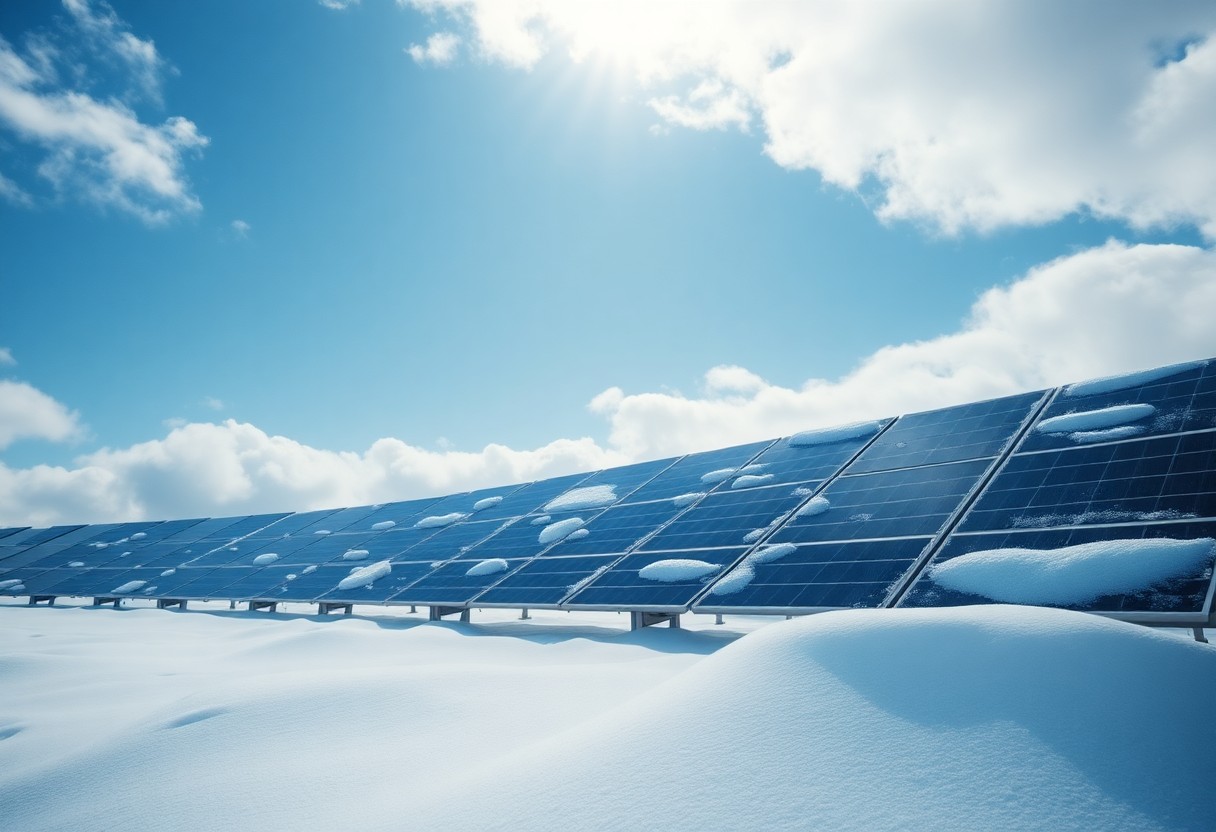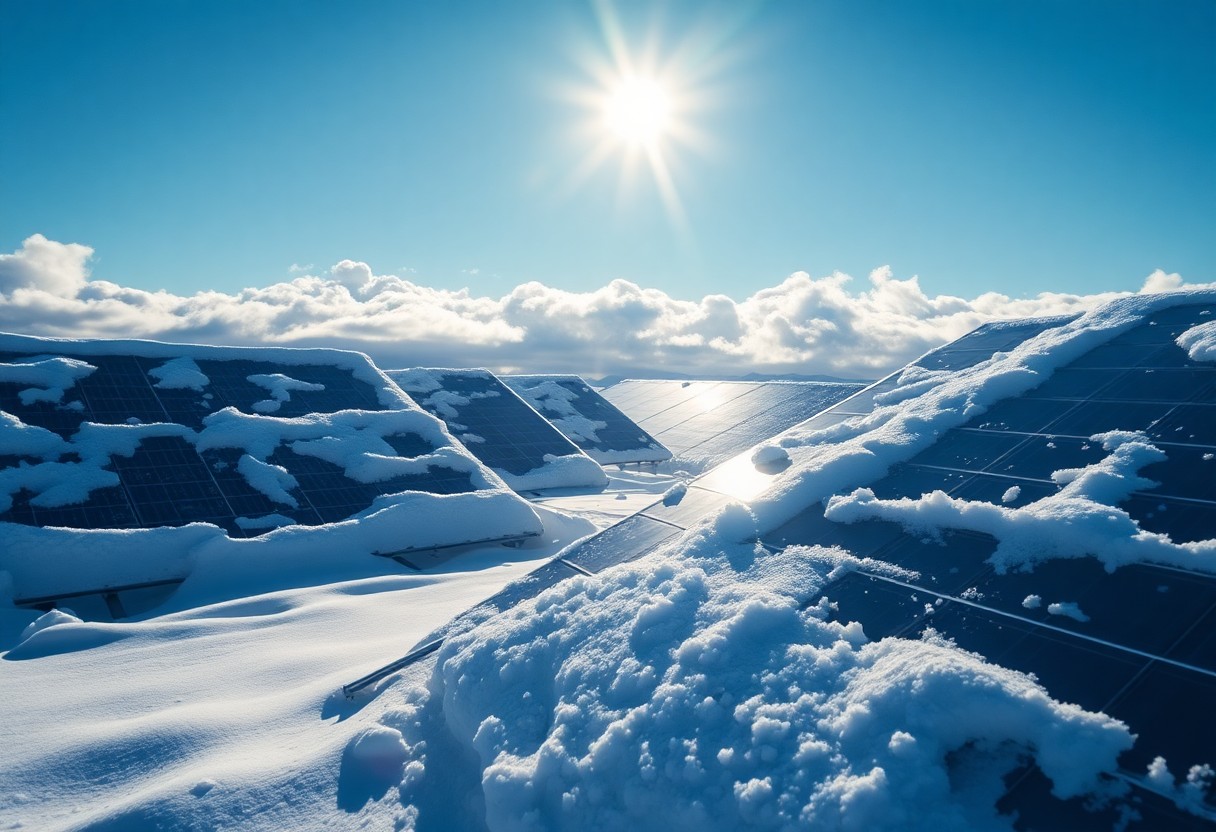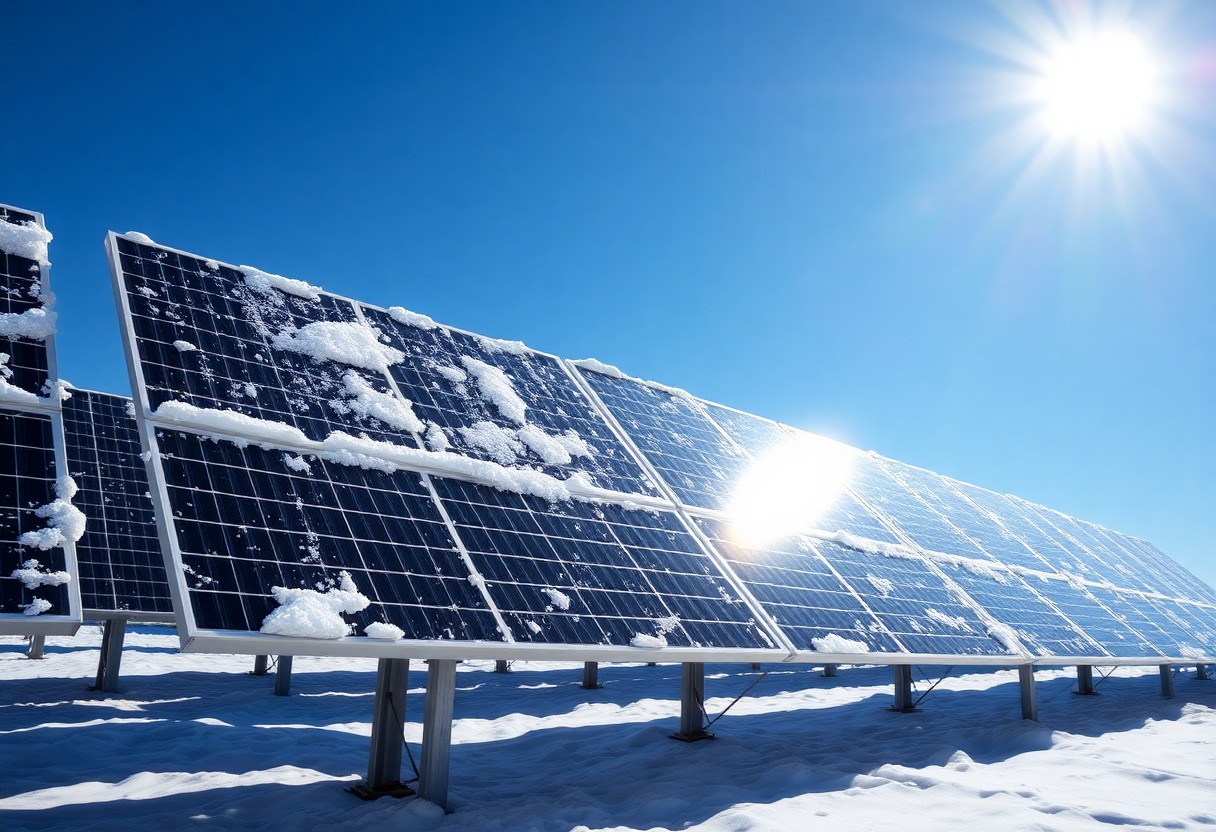It’s a common concern in winter: can your solar panels still generate power beneath a layer of snow? The good news is that solar panels are designed to be efficient even in cold weather, and they can still produce energy despite snow cover. However, heavy snow accumulation can hinder performance, potentially reducing your energy output. Understanding how your system works in winter conditions will help you maintain efficiency and maximize your investment, even when the weather turns chilly. Let’s explore how you can keep your solar panels thriving in the snow!
Key Takeaways:
- Solar panels can still produce electricity under snow, albeit at reduced efficiency due to the layer blocking sunlight.
- As snow melts or slides off the panels, their performance can quickly improve, often exceeding expectations for energy production thereafter.
- Proper installation and maintenance, including positioning panels at an angle, can help minimize snow accumulation and optimize energy output during winter months.
Understanding Solar Panels
The world of solar energy is fascinating yet complex. Before stepping into the impact of snow on solar panels, it’s necessary to grasp the basics of what these remarkable devices are all about.
What are Solar Panels?
Above all, solar panels are devices that capture sunlight and convert it into electricity. They are typically made up of many individual solar cells, which work collectively to harness solar energy efficiently. With growing environmental awareness, solar panels have become increasingly popular among homeowners and businesses alike.
How Solar Panels Work
Beside their impressive ability to generate electricity, understanding how solar panels operate can help you appreciate their functionality even more. These panels contain photovoltaic cells that convert sunlight into direct current (DC) electricity, which is then transformed into alternating current (AC) electricity for your home. The process involves several steps, including absorption, generation, and conversion.
Panels absorb sunlight using photovoltaic cells, which create an electric field. When sunlight strikes the cells, it knocks electrons loose, generating direct current (DC) electricity. An inverter then converts this DC electricity into alternating current (AC), which is used in your household appliances. This entire process allows you to harness solar energy efficiently and reduces your carbon footprint.
Types of Solar Panels
Panels vary significantly in design and application. You can choose among several types of solar panels to meet your energy needs:
- Monocrystalline Solar Panels: Known for high efficiency and space efficiency.
- Polycrystalline Solar Panels: Cost-effective, but generally less efficient than monocrystalline.
- Thin-Film Solar Panels: Lightweight and flexible, ideal for certain applications.
- Bifacial Solar Panels: Capture light from both sides, increasing efficiency.
- Building-Integrated Photovoltaics (BIPV): Stylish, integrated into building materials.
Assume that understanding these differences can help you make informed decisions based on your energy goals and available space.
| Type of Solar Panel | Key Feature |
|---|---|
| Monocrystalline | High efficiency, premium price |
| Polycrystalline | Affordability, lower efficiency |
| Thin-Film | Lightweight, flexible designs |
| Bifacial | Doubles light absorption |
| BIPV | Integrated with building materials |
Solar panels are designed to meet a variety of needs, and understanding the options will empower you to make the best choice for your situation. Each panel type has its distinct advantages, so examining your home environment and energy requirements can help you decide. Assume that making the right choice not only saves you money but also contributes positively to the environment.

The Science of Snow
If you find yourself gazing at the soft, white blanket of snow covering your solar panels, you might wonder about the science behind snow itself. Let’s research into the details of this fascinating phenomenon.
The Chemistry of Snow
Across the globe, snow is primarily composed of water molecules (H₂O) that crystallize under cold temperatures. When the temperature is below freezing, these molecules arrange themselves into unique hexagonal structures, creating beautiful snowflakes. The chemical composition of snow is usually pure, but various environmental pollutants can alter its purity.
How Snow Forms
For snow to form, moist air needs to cool and condense. As the temperature drops, tiny water droplets or ice crystals collide and bond together, creating larger snowflakes that fall to the ground when heavy enough. The whole process is a beautiful dance of physics and chemistry.
Understanding how snow forms can shed light on the weather patterns you experience. When warm, moist air rises and cools, it reaches a saturation point where it can no longer hold all the water. This leads to condensation, where water vapor turns into tiny ice crystals. These crystals eventually coalesce into snowflakes, and if conditions are right, they cascade to the ground, blanketing everything beneath them.
Different Types of Snow
Among the different types of snow, you have granular, wet, dry, and powdery varieties. Each type has unique properties that can affect your solar panels’ performance — particularly regarding insulation and light reflection.
| Type of Snow | Characteristics |
|---|---|
| Granular Snow | Has larger particles; firm texture |
| Wet Snow | Heavy and sticky; able to bond easily |
| Dry Snow | Crisp, airy; minimal moisture content |
| Powdery Snow | Fluffy and light; excellent for skiing |
| Sticky Snow | Forms snowballs; holds together well |
- Granular Snow can lead to major accumulation on solar panels
- Wet Snow can weigh down and potentially damage your solar system
- Dry Snow provides an easy way for sunlight to reach your solar panels
- Powdery Snow allows for quick evaporation when the sun shines
- Sticky Snow can cause blockages, affecting panel performance
Any type of snow can impact your solar panels, so knowing these variations is beneficial!
With all the different types of snow, each presents unique challenges and benefits for your solar panels. Understanding these can help you figure out how to keep your energy output at maximum levels through snowy seasons.
| Type of Snow | Impact on Solar Panels |
|---|---|
| Granular Snow | May accumulate, causing shading |
| Wet Snow | Heavy, may damage panels |
| Dry Snow | Less likely to stick, easy to clear |
| Powdery Snow | Melts quickly, minimal impact |
| Sticky Snow | Can create ice, requiring clearance |
- Granular Snow can accumulate if left untouched for too long
- Wet Snow is heavy enough to cause a drop in panel efficiency
- Dry Snow can be a temporary nuisance
- Powdery Snow reflects light beautifully
- Sticky Snow might require consistent management
Any knowledge about these phenomena helps you maintain your solar energy system better!
Solar Panel Efficiency in Cold Climates
Not only do cold climates present unique challenges for solar panels, but they can also enhance their efficiency in surprising ways.
The Impact of Temperature on Efficiency
Below, you will find some key points regarding the relationship between temperature and solar panel efficiency:
Temperature Effects on Solar Panel Efficiency
| Temperature Change | Efficiency Impact |
|---|---|
| Increased temperature (+25°C) | Decreased efficiency (around 10%) |
| Lower temperatures (-10°C) | Increased efficiency |
Benefits of Cold Weather for Solar Panels
Behind the chill, you may be surprised to find that cold weather can actually benefit your solar panels.
Temperature plays a significant role in how well solar panels operate. In fact, as the temperature decreases, your solar panels can generate more electricity than in warmer conditions. This is due to the fact that cold temperatures help reduce the amount of energy lost as heat, providing enhanced performance in icy climes. You might even notice that solar panels covered in snow can still produce energy—more than you expected!
Debunking Myths About Snow and Solar Panels
Cold weather often leads to misconceptions about solar panel efficiency, but it’s time to set the record straight.
In addition to surprising benefits, you may be interested to know that snow can actually be beneficial for your solar panels. Yes, that’s right! When snow covers your panels, it can help to reflect additional sunlight, subsequently increasing energy production once it melts away. This boosts output during winter sun, ensuring that your investment keeps paying off despite the bleak weather. Don’t be fooled by common myths—your solar panels remain capable of harnessing energy, even beneath a thick layer of snow.
Snow Coverage and Solar Panel Performance
After a fresh snowfall blankets your solar panels, you might wonder how this affects their ability to capture sunlight. Understanding how snow interacts with your panels can help you optimize their performance even during winter months.
How Snow Affects Sunlight Absorption
Any layer of snow covering your solar panels can block sunlight, reducing their ability to generate energy. If the snow is thick enough, it may completely obstruct the sunlight from reaching the photovoltaic cells, leading to a significant drop in energy production. When the snow melts or slides off, your panels can resume their efficient energy generation.
The Importance of Tilt Angles
About the tilt angle of your panels, it plays a significant role in their performance during snow coverage. A steeper angle helps prevent snow accumulation, allowing it to slide off more easily. This means that the orientation of your panels can directly impact how quickly they return to full functionality after a snowfall.
Panel installers often recommend angles between 30 to 45 degrees, especially in snowy regions. A tilt of this range not only helps with snow shedding but also enhances overall energy production by optimizing sunlight exposure year-round. Keeping this in mind can be beneficial in maximizing your system’s efficiency.
Snow Removal Techniques for Solar Panels
Between snowfall events, you may need to consider some snow removal techniques for your solar panels. Gently clearing off the snow can help restore energy production sooner rather than waiting for it to melt naturally.
Considering safety is paramount when removing snow from your panels. Use a soft broom or a roof rake with a long handle to avoid scratching the surfaces. Avoid using shovels or any tools that could damage the panels. Always prioritize your well-being by ensuring you have stable footing and, if necessary, Ask for assistance. Snow removal can boost your energy generation, but safety should always come first.
Real-Life Case Studies
To illustrate the performance of solar panels under snowy conditions, it’s valuable to look at real-life case studies from different regions. Here are some compelling examples highlighting their efficiency:
- Montana, USA: A solar farm in the Bitterroot Valley reported a 25% decrease in output during heavy snow, but recovered rapidly once thawed, showcasing impressive resilience.
- Alaska, USA: Residents of Anchorage with solar panels observed an average output of 75% compared to summer months, demonstrating that even in snow, efficiency remains relatively high.
- Sweden: A solar installation in Umeå recorded an impressive 70% functionality during winter months, thanks to tilt angles that allowed snow to slide off.
- Germany: In snowy regions like Bavaria, solar panels performed at a level of 80% of their potential due to reflective sunlight off the snow, enhancing overall energy production.
Success Stories: Solar Panels in Snowy Regions
Solar panels have shown remarkable success in snowy regions, even when faced with weather-related challenges. Behind innovation and strategic installation, many homeowners and businesses have experienced energy production levels that remain impactful despite the winter chill. These success stories not only enhance your understanding of solar resilience but also encourage others to adopt solar energy, leading to a more sustainable future.
Challenges Faced in Snowy Conditions
Before delving into solar energy benefits, it’s important to acknowledge the challenges snow can pose to solar panel performance. Snow accumulation can lead to shading, reduced sunlight exposure, and excess weight on the panels. These factors push you to consider installation angles and maintenance to ensure optimal functionality throughout winter.
The combination of snow and low temperatures can drastically affect solar panel output. Snow can cloud solar cells, blocking solar energy absorption. You might face situations where panels need manual clearing or special tilting to promote snow runoff. Balance is necessary; while snow cover may initially inhibit efficiency, the reflective property of snow can enhance energy generation when sunlight penetrates.
Comparative Analysis of Performance Metrics
Faced with the unique challenges snowy conditions pose, understanding how solar panels perform can be enlightening. Below is a breakdown of performance metrics based on various case studies during the winter months:
Performance Metrics Comparison
| Region | Winter Output (% of Summer Output) |
|---|---|
| Montana, USA | 75% |
| Alaska, USA | 50% |
| Sweden | 70% |
| Germany | 80% |
It’s fascinating to see how different regions adapt and optimize solar panels for success in the snow. Understanding the performance metrics allows you to make informed decisions about solar investments tailored to your local climate, ultimately ensuring you enjoy the benefits of renewable energy year-round.
Innovations and Technologies
Now, it’s time to explore how modern advancements are making it possible for solar panels to perform even under snowy conditions. Innovations in solar technology are addressing the challenges posed by snow accumulation, ensuring that you can still harness that precious sunlight, come rain or shine!
Solar Panel Designs for Snowy Environments
Beside traditional flat designs, solar panels tailored for snowy environments feature enhanced slopes that allow snow to slide off easily. Improved materials and coatings also help maintain efficiency in cold weather, so you won’t have to worry about your energy production during winter months.
Advances in Snow-Shedding Technology
Above all, new technologies like self-cleaning coatings and specific panel angles are revolutionizing how snow is managed on solar panels. These innovations ensure that you receive the maximum sunlight exposure, even when winter blankets your panels in white.
The self-cleaning surfaces use a combination of hydrophobic and hydrophilic materials that not only prevent snow accumulation but also allow rain or melting snow to wash away dirt and debris. Therefore, you can expect your solar panels to operate efficiently even when the elements are not in your favor.
Future Trends in Solar Panel Efficiency
An exciting direction for solar technology is the development of high-efficiency panels, specifically designed for lower light conditions often found in snowy regions. These panels maximize energy capture, giving you peace of mind that your investment will continue to pay off throughout the winter season.
Hence, manufacturers are focusing on optimizing solar cell materials and designs that excel in diffused light, ensuring that your solar systems are not only effective in ideal conditions but also resilient against the challenges presented by winter weather. Your commitment to clean energy can remain strong, no matter the season!
Final Words
With these considerations in mind, you can confidently approach the idea of solar panels thriving beneath a chilling veil of snow. While snow may temporarily cover your panels, the benefits of sunlight on even a winter day often shine through, allowing your system to generate energy. By understanding how snow interacts with solar technology and taking proactive steps, you can ensure optimal performance year-round. Embrace the power of solar energy, knowing that winter’s chill doesn’t have to dim your renewable energy aspirations!
Q: Can solar panels generate electricity when covered in snow?
A: Yes, solar panels can still generate some electricity even when partially covered in snow. Solar panels are designed to absorb sunlight, and while heavy snow can significantly block sunlight, a thin layer of snow may allow some light to reach the panels. Additionally, sunlight can reflect off the white surface of the snow, further aiding in energy generation. However, if the panels are completely covered, their efficiency will drop substantially until the snow melts or is cleared away.
Q: How do solar panels perform in cold temperatures?
A: Solar panels often perform better in cooler conditions than in extreme heat. Cold weather can increase the efficiency of the solar cells, allowing them to convert sunlight into electricity more effectively. While heavy snow can hinder performance, the cooler temperatures can still be beneficial for the overall functionality of solar energy systems, provided that the panels are not obstructed for extended periods.
Q: What can be done to maintain solar panel productivity during snowy conditions?
A: To maintain productivity during snowy weather, homeowners can take several actions. First, ensuring that the solar panels are installed at an optimal angle will help the snow slide off more easily. When safe to do so, manually removing snow from panels can also enhance performance. Another option is to invest in heating elements that can help melt snow and ice on the panels. Regular maintenance and monitoring can help ensure optimal functioning throughout winter months.

